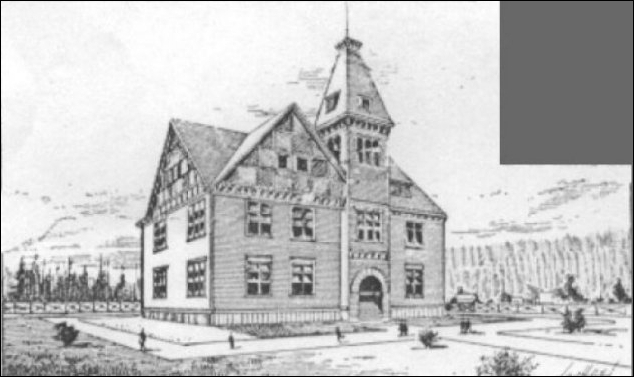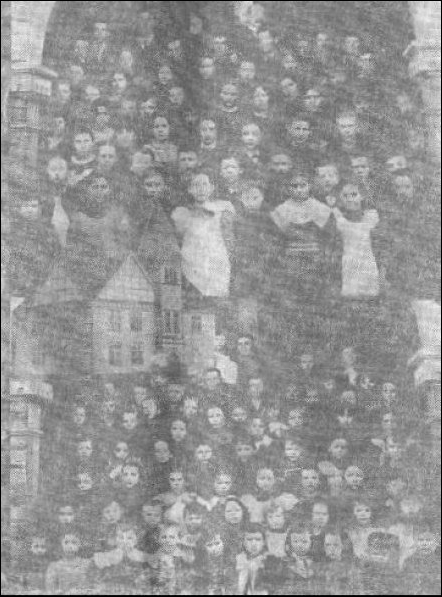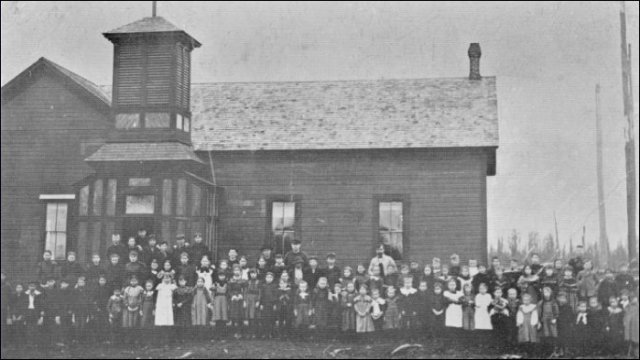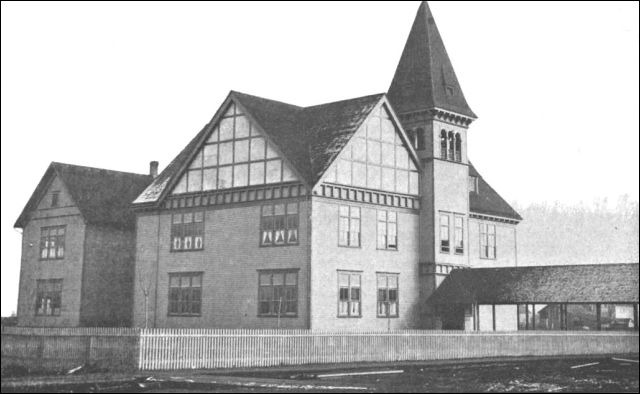
|
of History & Folklore
Subscribers Edition, where 450 of 700 stories originate
The most in-depth, comprehensive site about the Skagit
Covers from British Columbia to Puget Sound. Counties covered: Skagit, Whatcom, Island, San Juan, Snohomish & BC. An evolving history dedicated to committing random acts of historical kindness
|
Noel V. Bourasaw, editor  810 Central Ave., Sedro-Woolley, Washington, 98284 810 Central Ave., Sedro-Woolley, Washington, 98284
Home of the Tarheel Stomp  Mortimer Cook slept here & named the town Bug Mortimer Cook slept here & named the town Bug
|

|
Site founded Sept. 1, 2000. We passed 5 million page views on June 6, 2011
The home pages remain free of any charge. We need donations or subscriptions to continue.
Please pass on this website link to your family, relatives, friends and clients.
|
Early Sedro-Woolley Schools,
Chapter 2: graded schools of Sedro and Woolley
By Noel V. Bourasaw, Skagit River Journal of History & Folklore ©2002, expanded 2011
Woolley Graded School, 1890-98 . . .
Sedro Graded School, 1891-1926
How schools were funded and Barefoot Schoolboy law . . .
Sedro graded school, Franklin and Irving
On Dec. 27, 1890, a special election was held in District 27 to consider building a new school. Present school officials would kill for the winning margin: 39 to 1, approving a $10,000 bond. The county also pitched in $1,000 for furniture.
Norman R. Kelley, the bachelor empire builder of new Sedro and lead man for the Seattle Lake Shore & Eastern Railway donated a full square block, #61, from the Sedro Land and Improvement Company holdings. There was a spot for a new school set way back from the southeast corner of Talcott and Sixth streets. That was roughly the same location where Central School was built in 1926. During the summer a six-room building was erected with large spacious rooms. Only two were filled initially for the fall term but the planners showed great foresight in allowing for immediate growth in the school population. At a special school election on Dec. 27, 1890, voters approved bonds by a vote of 39 to one to be issued at $10,000 value: $3,000 for five years, $3,000 for ten years and $4,000 for fifteen years. In March, bids were sought for a $6,500 building that could seat 300 pupils. The county school district provided $1,000 for furniture.
Originally also called the Sedro Graded School, this school would be called Franklin, starting in 1902, but we will explain that in Chapter 3. Isaac P. Rich and Miss Mina Cederbrand were the teachers, with Rich's salary set at $80 per month. Sedro druggist A.E. Holland was clerk; he had to walk a few blocks east from his store [in new Sedro, present site of the high school] for meetings.
Students for this school came from areas all around the new town, up to three miles away. When the school was being built, Skiyou students were still included in the census and funds were pledged, but then Skiyou parents decided to form their own district, which eventually became #39. Since the Sedro district planned on serving those students, the decision caused considerable consternation and this is the first instance we can find of lawyers being called in to solve a school-districting problem.

|
This is a drawing of the Sedro Graded School just as it opened in the fall of 1891 as a new six-room school. It was erected at the southeast corner of 6th street at Talcott, on Block 61 of the First Addition to Sedro, which was donated by Norman R. Kelley's Sedro Land and Improvement Co. As you can see, the school is set back considerably from the streets. When the new Central School was built on the site in 1926, it was wrapped in an L-shape around Franklin School so part of the old building could be used through the spring.
After the first high school was built in 1901, north across Talcott Street, students held an election to name the old graded school and it became known as Franklin, as we explain in future Chapter Three.
|
The first directors for the new school district were David Moore, whose family was the namesake Moore street, now Highway 20; George Gregory and F.A. Douglass. Men of the town donated their labor to clear the land and erect the building and another room was soon added as more families moved into Woolley. The 1937 History of School District #70 notes that subscriptions were taken, lectures given and individuals made donations for school funds. Edward Uhland taught the first 1891 term. The clerk was W.T. Odlin, who was originally a clerk for Mortimer Cook's store at Sterling and would soon be the cashier for C.E. Bingham's bank in Sedro.
Teachers at the graded school
 |
Franklin school class from an 1899 Courier-Times.
|
There were initially only enough pupils for two rooms but the school board showed great foresight because within a few years a 4-room addition would be required for the explosion in school-age children. William Bell had moved on in 1891 so the first session of winter 1891-92 was taught by two teachers, a male and a female, with the male paid a higher salary of $80 per month. Fairie Cook had to return home after the 1893 financial panic set in, and she taught the 1893-94 term along with the Rev. G.L. Cuddy of the M.E. church. Three years later, the 1896-97 term was stretched to 9 months, the longest session so far. There was still no high school, so parents who did not want to teach at home were forced to send their children to school at Mount Vernon or to more sophisticated high schools in Seattle and Tacoma.
In the 1892-93 term, J.J. Gallagher was hired as principal and Miss Cederbrand was his assistant. For that term, the board fixed the tuition of non-resident students at $10 per quarter. The fear of smallpox in these small frontier communities was evident since a pupil was not admitted unless he or she either had a history of smallpox or had been vaccinated.
New teachers were hired for the 1893-94 term: Fairie Cook and the Rev. G.L. Cuddy, the beloved minister of the Methodist Episcopal church, moved over to Sedro after teaching at Woolley. The next three years were economically devastating for the local area as well as the nation, as capital dried up and dozens lost their homesteads and employment during the panic that was just as severe as the Depression 40 years later.
For the 1894-95 session, J.W. Faulkner and Miss Lulu Richards were hired. Years later, Mattie Hight Wicker (wife of Charles Wicker Sr., the owner of Skagit Realty) recalled that her family moved here that year. They moved from Ballard, another small timber town that was growing north of Seattle, and Mr. Faulkner's brother was her teacher there. For the 1895-96 term, Catherine Coutaut and Miss Eunice Smithson were hired as teachers and F.E. Wiggins was clerk. 1896-97: Susan Lord Currier from Mount Vernon taught six months; Mrs. M. Drake also six months; R.M. Wansbrough [maybe Wainsbrough] two months. F.F. Willard was clerk.
That was one of the last, if not the last, teaching position by Miss Currier. She had quite a future ahead of her. Born in Concordia, Kansas, in July 25, 1871, she moved west with her parents as a young girl and took college-level courses at Coupeville after graduating from LaConner. She then attended Oberlin college in Ohio along with Nina Cook, Mortimer Cook's daughter, and graduated in 1895. She took post-graduate work at Berkeley before returning to Skagit county to teach. In 1898 she was elected as county school superintendent and was reelected in 1900. On Oct. 30, 1902, she married Frederick L. Ornes, editor of the Anacortes American newspaper. From 1900-04 she was also publisher of the Skagit School Bulletin newspaper. She died very young,in 1906. We will soon post her obituary and the story of her life.
The term of 1897-98 had the first recorded nine-month term. The teachers were R.M. Wansbrough and M.M. Look and George Hoskinson was clerk. We do not have lists of teachers for the next two terms.
Woolley graded school
Back in 1890 a new company town was growing less than a mile northwest of the Sedro school. P.A. Woolley moved his wife and family out here in the fall of 1889 and built the Skagit River Lumber & Shingle Company at the crossing of the three rail lines just northeast of where the Sims Ford Ranch stands in 2002. Although most of the workers were bachelors, they were a handful of families with children. Beginning that spring, Mrs. Catherine Woolley taught them all at a small school set up in part of the mill cookhouse/commissary. Because the records are confusing, we are unclear about whether the cookhouse was located next to the mill or in the 200 block of Puget. She also taught Sunday School in her non-denominational "church parlors" in her home on Gibson street. Ethel Van Fleet's records indicate that "interested parties" donated funds for the school. P.A. was not yet a wealthy man but that would soon change. According to the Illustrated History of Skagit and Snohomish Counties, written in 1906, she soon taught 22 pupils, some who walked two miles through the forest for the privilege.

|
This photo of the Woolley Graded School was probably taken near the end of its use as a school, roughly 1897-99, judging from the large number of students. This original Woolley School stood just north of the Seattle & Northern Railroad tracks, near the northwest corner of Murdock street and Northern Avenue, on land donated by Philip A. Woolley.
|
Mrs. Catherine Woolley set up the first school for her husband's company town in the spring of 1890 and there was no money for school purposes, except by donation, so she was the teacher at the beginning and she also taught Sunday School in her non-denominational church parlors in their family home. For the fall term of November 1890 George Raymond was hired to teach a full term, probably three months, in the larger upstairs room of the Woolley cookhouse.
School continued in those cramped quarters because the town was not yet incorporated, which was necessary to acquire tax funds. Philip A. Woolley began organizing his company town as a city on April 9, 1890, it was platted on June 3, 1890, and a ratification election approved incorporation as a city of the fourth class on May 11, 1891. For the 1891 school term, School District #45 was formed and a new schoolhouse was erected at the corner of Northern Avenue and Puget Avenue, north of the Seattle & Northern tracks on lots donated by William Murdock's Grand Junction Land Company. Murdock was elected the first mayor of the town of Woolley that year. Although they are now called streets, the north-south streets east of Murdock from Puget through Haines were originally designated as avenues.
Ethel Van Fleet Harris noted that funding included donations by the mills in the area. The men from the mill and early businesses cleared the land and completed the school. Edward Uhland taught the first term there, which lasted just four weeks for 22 students. W.T. Odlin, the cashier of the C.E. Bingham Bank, was the clerk. From then until 1899 the terms alternated from 12 to 24 weeks. Initially the Rev. G.L. Cuddy was the school teacher but he moved to Sedro to teach and also moved the Sunday school from Woolley school to the M.E. church on Jameson. At least that was the location mentioned in the brief record. We do not have any information about that church located on Jameson, but instead at the corner of Fidalgo and Township, along with the early St. Elizabeth's hospital. We hope a reader will have more information about those years; the newspapers were lost or burned many years ago. Upon the merger of the towns the two districts also consolidated and became District 70 on April 29, 1899.
Many discussions were held, starting in 1892, to consolidate the two districts but they remained separate until 1899, after the merger of the towns. At first, Rev. Cuddy conducted Methodist Episcopal services at the Woolley school but as room was needed for a growing body of students, the M.E. services were moved in July 1892 to the new church on Township road.
When the summer term started on July 7, 1892, Uhland was hired to teach for 24 weeks at $60 per month. Lulu Richards was soon hired to teach 12 weeks at $50 per month. F.A. Douglass, the pioneer Woolley druggist, replaced Odlin as clerk. For 1893, Rev. Cuddy taught for 24 weeks, Thomas Roush for 12 and Miss Lulu Richards for 12. 1894: Rev. Cuddy then moved over to Sedro Graded School to teach. Roush and Richards taught, with Norris Ormsby, the owner of a freight business, serving as clerk. In 1895, Philip Cole and Helen I. Wells taught. 1896: Philip Cole and Helena Rouse taught.
In 1897 A.L. Swim [or Swaim] taught for eight weeks and Clara Garl Morrison, daughter of a Burlington pioneer, finished the last eight weeks of the term. In 1898 T.H. Look and Miriam Elliott taught and F.A. Douglass continued as clerk, having started in 1895.

|
This is an actual photo of the Sedro Graded School, early on but after an addition was added to the east with a covered walkway. The school opened in the fall of 1891 as a new six-room school. It was erected at the southeast corner of 6th street at Talcott, on Block 61 of the First Addition to Sedro, which was donated by Norman R. Kelley's Sedro Land and Improvement Co. This photo is of the students in front of the school in 1894, courtesy of an old copy of the Sedro-Woolley Courier-Times.
|
Outlying districts
The Cokedale district school began October 24, 1891, and was called Jennings because T.S. Jennings was superintendent of the mine then. Skiyou district formed in March 1891 and hired Mr. L.M. Kirk as its first teacher; he was also a druggist for A.E. Holland at his new location in new Sedro. Early directors included pioneers J.M. Harrison, George Arnold and Joseph Wilson. Hamilton District 12 was organized in 1884 by pioneer Valentine Adam and school started in November 1886. Other early districts were: Warner #23 organized Jan. 27, 1885, school started 1887; Birdsview 1885; Lyman 1886; Day creek 1888; Utopia 1898; Ehrlich 1899; McRae 1899; Big Lake 1900.
How schools were funded and the Barefoot Schoolboy law
Back in March 1891 the Graphic magazine featured a Washington Special Section where the town of Woolley was featured. Here we read a hint of how schools were funded in those early days. The story notes: "The handsome new school house would do credit to a city many times its size. School lands five miles from Woolley appraised $80 per acre but brought $156 at public sale."
In the Book of Counties, written in 1953 for the centennial of Washington territory, we get more information about local school taxation. First, every white male in the county over the age of 21 paid an annual poll tax to the county and then all property in the county was classified as to tax status. If it was government land or belonged to a school district, a religious or charitable institution, or a public library or cemetery, or was owned by an Indian or reservation, it was exempt. It is also interesting to note that that a man could choose to donate work on county roads in lieu of his taxes.
The county assessor was charged with making up an assessment roll, which he delivered to the county commissioners for their annual June session. The commissioners determined the amount of money to be raised for county purposes and figured in the school taxes required by law, which were one mill for territorial purposes and two mills for schools. General county taxes could not exceed four mills and the total property levy for the county, including school taxes, could not exceed nine mills.
Before our constitution was adopted, the General Land Ordinances were written in 1785-87 and the continent was divided into postage-stamp sections of townships and ranges or the purpose of selling land. Section 16 in every township was reserved specifically for the support of schools within those townships. When California was admitted as a state in 1850, it became the first state to receive two sections per township for schools, and other Western states followed.
The next significant change in school funding came in the election period of 1896, when the country was still trying to recover from the Financial Panic of 1893 and populism took hold. That year was the genesis of the Equality Colony near Bow, about ten miles northwest of Woolley. A coalition called the Fusionists, which included a mix of Silver Republicans, Democrats and Populists, overcame the prior Republican domination in Washington state and John R. Rogers of Puyallup was elected governor.
While in the state legislature, Rogers drafted and secured passage of the "barefoot schoolboy bill," which is credited as being the beginning of free public school education in Washington state. The law required the state to pay school districts six dollars per year for every child enrolled in school. It also required cities to bear part of the expense of funding country schools. That egalitarian idea especially aided districts in rural areas such as in Skagit county.
Links, background reading and sources
- Portal section to the earliest Sedro-area schools, with links to all school features.
- Mary Purcell, 45 year teacher at Sedro elementary schools and namesake for the new primary school in 1951.
Story briefly posted on Feb. 23, 2003, revived and totally updated
and moved to this domain Dec. 25, 2011
Please report any broken links so we can update them
This article originally appeared in Issue 59 of our Subscribers-paid Journal online magazine
 Remember; we welcome correction & criticism. Remember; we welcome correction & criticism.
 Please report any broken links or files that do not open and we will send you the correct link. With more than 700 features, we depend on your report. Thank you. And do not give up if you find a link that seems to be closed. Just put the subject in the search box below. The story may have been moved to our new domain. Or just ask us and we will guide you to it. Please report any broken links or files that do not open and we will send you the correct link. With more than 700 features, we depend on your report. Thank you. And do not give up if you find a link that seems to be closed. Just put the subject in the search box below. The story may have been moved to our new domain. Or just ask us and we will guide you to it.
 Did you enjoy this story? Remember, as with all our features, this story is a draft and will evolve as we discover more information and photos. This process continues until we eventually compile a book about Northwest history. Can you help with copies or scans of documents or photos? We never ask for your originals. Did you enjoy this story? Remember, as with all our features, this story is a draft and will evolve as we discover more information and photos. This process continues until we eventually compile a book about Northwest history. Can you help with copies or scans of documents or photos? We never ask for your originals.
 Read about how you can order CDs that include our photo features from the first ten years of our Subscribers-paid online magazine. Perfect for gifts. Although it was delayed by our illness, it is due for completion in 2012. Read about how you can order CDs that include our photo features from the first ten years of our Subscribers-paid online magazine. Perfect for gifts. Although it was delayed by our illness, it is due for completion in 2012.
|
You can click the donation button to contribute to the rising costs of this site. See many examples of how you can aid our project and help us continue for another ten years. You can also subscribe to our optional Subscribers-Paid Journal magazine online, which celebrated its tenth anniversary in September 2010, with exclusive stories, in-depth research and photos that are shared with our subscribers first. You can go here to read the preview edition to see examples of our in-depth research or read how and why to subscribe.
|
|
You can read the history websites about our prime sponsors
Would you like information about how to join them in advertising?
 Our newest sponsor, Plumeria Bay, is based in Birdsview, just a short walk away from the Royal family's famous Stumpranch, and is your source for the finest down comforters, pillows, featherbeds andduvet covers and bed linens. Order directly from their website and learn more about this intriguing local business. Our newest sponsor, Plumeria Bay, is based in Birdsview, just a short walk away from the Royal family's famous Stumpranch, and is your source for the finest down comforters, pillows, featherbeds andduvet covers and bed linens. Order directly from their website and learn more about this intriguing local business.
 Oliver-Hammer Clothes Shop at 817 Metcalf Street in downtown Sedro-Woolley, 90 years continually in business. Oliver-Hammer Clothes Shop at 817 Metcalf Street in downtown Sedro-Woolley, 90 years continually in business.
 Peace and quiet at the Alpine RV Park, just north of Marblemount on Hwy 20, day, week or month, perfect for hunting or fishing. Park your RV or pitch a tent — for as little as $5 per night — by the Skagit River, just a short drive from Winthrop or Sedro-Woolley. Alpine is doubling in capacity for RVs and camping in 2011. Peace and quiet at the Alpine RV Park, just north of Marblemount on Hwy 20, day, week or month, perfect for hunting or fishing. Park your RV or pitch a tent — for as little as $5 per night — by the Skagit River, just a short drive from Winthrop or Sedro-Woolley. Alpine is doubling in capacity for RVs and camping in 2011.
 Check out Sedro-Woolley First section for links to all stories and reasons to shop here first Check out Sedro-Woolley First section for links to all stories and reasons to shop here first
or make this your destination on your visit or vacation.
 Are you looking to buy or sell a historic property, business or residence? Are you looking to buy or sell a historic property, business or residence?
We may be able to assist. Email us for details.
|
Did you find what you were seeking? We have helped many people find individual names or places, so email if you have any difficulty.
|
Tip: Put quotation marks around a specific name or item of two words or more, and then experiment with different combinations of the words without quote marks. We are currently researching some of the names most recently searched for — check the list here. Maybe you have searched for one of them?
|
Please sign our guestbook so our readers will know where you found out about us, or share something you know about the Skagit River or your memories or those of your family. Share your reactions or suggestions or comment on our Journal. Thank you for taking time out of your busy day to visit our site.
|

View My Guestbook
Sign My Guestbook
|
Email us at: skagitriverjournal@gmail.com

Mail copies/documents to Street address: Skagit River Journal, 810 Central Ave., Sedro-Woolley, WA, 98284.
|

 810 Central Ave.,
810 Central Ave., 



